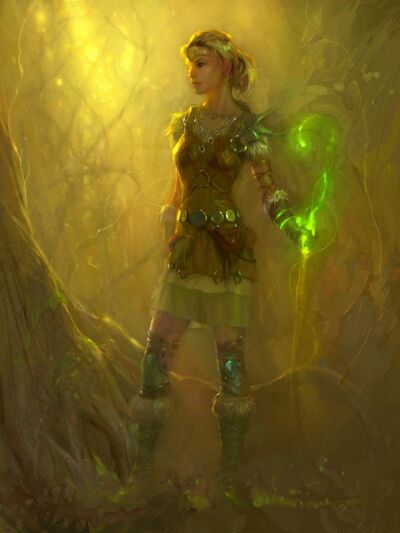Shaman

3rd Edition D&D
Not to be confused with the Spirit Shaman or the Dragon Shaman as those classes both work in entirely different ways.
The 3rd Edition Shaman class was released in the Oriental Adventures sourcebook as a replacement for Clerics & Druids, since neither of those were argued to have been particularly "Oriental". It actually did a pretty good job of it too and made for quite a useful PC class. Though ironically it was not included as available to players in the Rokugan campaign setting which was the book's "standard" setting.
It had the Druid's Animal Companion as well as the Turn/Rebuke Undead ability (although at reduced level) and the ability to spontanteously convert cure spells from the Cleric, it could see Spirit creatures at will (both Incorporeal & Ethereal). It had access to up THREE Domains, though chosen from a different list from the standard cleric selection, though the choice is not dictated by any particular deity and some of the domains were exactly the same, so you could get combinations that core clerics would never be able to get.
Shamans also got a selection of Monk-like bonus feats, starting with Improved Unarmed Strike but could grow up to the various martial arts forms too.
On the down-side, they don't start with the same weapon and armour proficiencies as either the Druid or Cleric, and despite all of the combat feats, they are still no-where near as effective as a monk in combat. The best thing to do is to get the better armour proficiencies as early as you can, or you can act in an Arcane equivalent role, since you can always buff yourself up with spells.
4th Edition D&D
Like a Warlord, but less cool and more primitive. Basically, you chant and wardance buffs onto other PCs, while summoning animal spirits.The primary advantage of the Shaman is the very clunky and somewhat broken summoned animal, which is nearly impossible for monsters to destroy. Additionally, the healing mechanic for the shaman gets around the 'use a surge to heal' paradigm, which breaks an important aspect of the game.
A solitary class they feel no need to seek adventure instead spending their time improving their skills. They usually get pulled into trouble anyway due to their usefulness. They are most commonly known for their wide use of the elements and not to be mistaken for Druids. If they feel the need they will use totems, usually hung around the neck or wrist, to help channel their power.
One of the most popular things Shamans are known for is their ability to summon various creatures. What a shaman can summon depends on his dedication to the art and luck. Most creatures summoned by the average shaman will look half put together and often gruesome adding on a small fear factor the otherwise smaller and less intimidating shaman. Occasionally you'll run into a more accomplished one who can summon all sorts of things, if it doesn't look like it'll kill you, run.
In group mechanics shamans are most likely used for their buffing and healing abilities. The buffs shamans have to offer span everything the elements touch from boosts to resistances. While their healing abilities aren't top of the line it's hard to argue against someone who can also summon a creature that will eat you.
| Dungeons & Dragons 4th Edition Classes | ||
|---|---|---|
| Player's Handbook 1 | Cleric • Fighter • Paladin • Ranger • Rogue • Warlock • Warlord • Wizard | |
| Player's Handbook 2 | Avenger • Barbarian • Bard • Druid • Invoker • Shaman • Sorcerer • Warden | |
| Player's Handbook 3 | Ardent • Battlemind • Monk • Psion • Runepriest • Seeker | |
| Heroes of X | Blackguard* • Binder* • Cavalier* • Elementalist* • Hexblade* • Hunter* • Mage* • Knight* • Protector* • Scout* • Sentinel* • Skald* • Slayer* • Sha'ir* • Thief* • Vampire* • Warpriest* • Witch* | |
| Settings Book | Artificer • Bladesinger* • Swordmage | |
| Dragon Magazine | Assassin | |
| Others | Paragon Path • Epic Destiny | |
| *·: Non-AEDU variant classes | ||